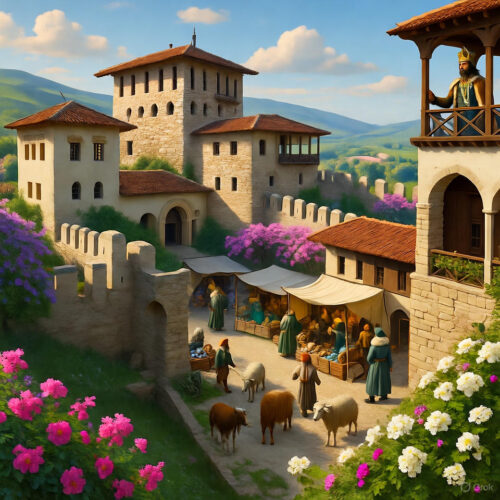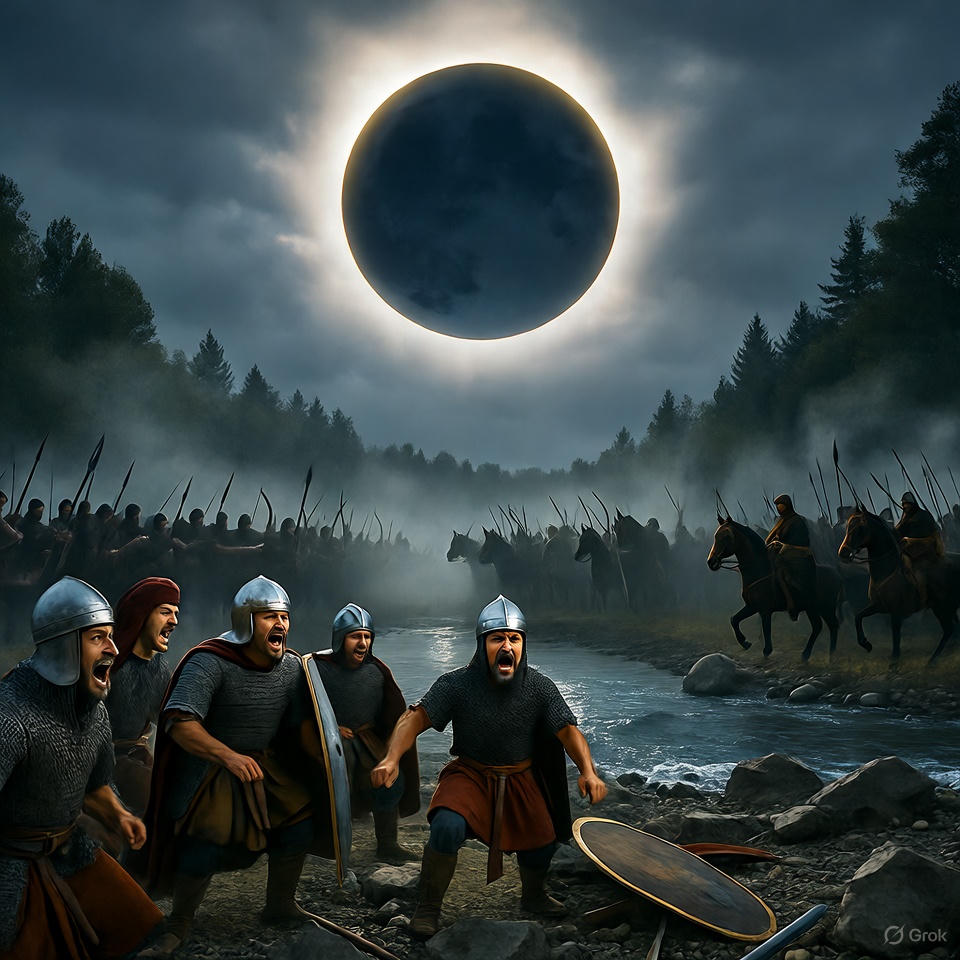Picture this: It’s a crisp autumn morning in the shadow of the jagged Haemus Mountains, where the wind carries the faint echo of shepherd’s flutes and the distant rumble of ox carts laden with wool. The year is 1185, and the air in the rugged valleys of Moesia—modern-day northern Bulgaria—thickens with unspoken fury. For nearly two centuries, the iron fist of the Byzantine Empire has crushed the spirit of the Bulgarian people, turning proud warriors into taxed serfs, their ancient tsars reduced to dusty legends. But on October 26, the feast day of St. Demetrius, the patron saint of soldiers and the oppressed, two brothers ignite a spark that will blaze into the rebirth of a nation. This is the story of the Uprising of Asen and Peter, a tale of defiance, cunning, and sheer audacity that toppled an empire’s grip and birthed the Second Bulgarian Empire. It’s a saga dripping with betrayal, divine omens, nomadic horsemen thundering across steppes, and the gritty determination of a people who refused to kneel.
What makes this event leap from the annals of history? It’s not just another rebellion in the endless chess game of medieval empires. On this single day, a tax collector’s demand morphed into a declaration of independence, weaving together Bulgarian resilience, Vlach pastoral cunning, and Cuman cavalry charges into a tapestry that redrew the map of the Balkans. Over the next two years, this uprising would force the mighty Byzantines—successors to Rome, guardians of Christendom—to sue for peace, ceding vast territories and recognizing a new sovereign state. And here’s the fun twist: it all started over a wedding bill. Yes, an emperor’s nuptials nearly bankrupted a province, proving that even the grandest thrones can tumble from the weight of a misplaced coin. As we dive deep into this forgotten corner of history, we’ll uncover layers of intrigue that rival any epic novel—think *Game of Thrones* but with more Orthodox icons and fewer dragons. By the end, you’ll see how this 12th-century roar echoes into your life, arming you with tools to shatter your own chains. But first, let’s roll up our sleeves and excavate the dirt of the past.
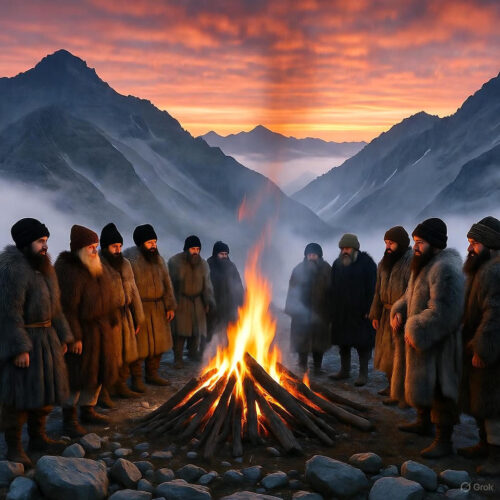
To understand the explosion of 1185, we must trek back through the labyrinthine corridors of Byzantine-Bulgarian relations, a saga as convoluted as a minotaur’s maze. The First Bulgarian Empire, forged in the fires of the 7th century by Khan Asparuh’s hordes crossing the Danube, had been a thorn in Byzantium’s side for over 300 years. Under tsars like Simeon the Great (893–927), Bulgaria swelled into a cultural colossus, its script (Cyrillic, born from the missionary brothers Cyril and Methodius) spreading literacy like wildfire, and its armies humbling emperors from Constantinople. Simeon’s dream? To don the purple robes of a Roman basileus himself. He nearly did, sacking Adrianople and besieging the Queen of Cities in 924. But hubris felled him; his son Peter I (927–969) squandered the gains in decadence, inviting Byzantine spies and assassins into the court.
Enter Basil II, the “Bulgar-Slayer,” emperor from 976 to 1025. This relentless autocrat, whose eyes burned with the fervor of a desert monk, launched a 30-year war of annihilation. By 1018, after the heartbreak of Tsar Samuel’s blinding of 14,000 Bulgarian prisoners (an act so horrific it allegedly broke Samuel’s heart and killed him), the First Empire crumbled. Bulgaria became a Byzantine theme—a province milked for taxes, soldiers, and grain. The boyars (nobles) were exiled or co-opted; churches were rededicated to Byzantine saints; and Bulgarian identity simmered underground, preserved in monasteries like those at Rila, where monks copied manuscripts by candlelight, whispering tales of lost glory.
Fast-forward to the 12th century, and the Komnenian restoration under Alexios I (1081–1118) and John II (1118–1143) briefly stabilized the empire. But it was Manuel I Komnenos (1143–1180) who dreamed big—too big. A charismatic warrior-poet, Manuel fancied himself a new Alexander, allying with the Crusader states, flirting with the Holy Roman Empire, and even jousting in tournaments disguised as a knight-errant (a fun fact: he once unhorsed the King of Hungary in a melee, earning eternal grudges). Against Bulgaria, Manuel played divide-and-conquer, resettling Vlachs (Latin-speaking nomads akin to modern Romanians) in the Haemus foothills as buffer herders, while arming select Bulgarian magnates. His 1160s campaigns crushed a revolt by Ivan Vladislav’s descendants, but at a cost: the land bled, farms lay fallow, and resentment festered like an untreated wound.
Manuel’s death in 1180, after a hunting accident that left him lingering in agony for days, plunged Byzantium into chaos. His widow, Maria of Antioch—a Norman beauty with a knack for court gossip—regented for their son Alexios II, a boy of 11. The regency devolved into a bloodbath: riots in Constantinople, Andronikos I Komnenos (Manuel’s cousin, a silver-tongued tyrant with a harem of 300 concubines) slithering back from exile to massacre the regency and strangle young Alexios. Andronikos ruled 1183–1185 in a reign of terror, executing nobles on whims and marrying his 13-year-old daughter to a puppet emperor. The Balkans, neglected, became a powder keg.
Enter Isaac II Angelos, proclaimed emperor on September 7, 1185, after a mob lynched Andronikos. Isaac, a middling bureaucrat with a taste for falconry and dice, inherited an empire teetering on bankruptcy. Wars with Seljuk Turks nibbled the east; Norman pirates raided the west; and the treasury yawned empty. To shore up alliances, Isaac betrothed himself to Maria Komnene, niece of Manuel I and daughter of the Hungarian king Béla III—a match sealing a frontier pact but demanding a dowry of gold talentae (about 60 pounds each). Where to find the funds? The Haemus Mountains, of course—home to hardy Bulgarian farmers tilling barley fields, Vlach shepherds trailing goats across alpine passes, and Cuman scouts eyeing borders from the steppes.
The tax edict hit like a blizzard: every household in the theme of Paristrion (the Byzantine district north of the Haemus) owed a levy equivalent to a month’s harvest. Collectors, armored taxmen from Thrace, rode into villages with ledgers and whips, seizing cattle and grain silos. In Tarnovo (then a fortified hill town called Zlatna or “Golden”), whispers turned to curses. Here lived the Asen family—minor boyars of mixed Bulgarian-Vlach blood, their name possibly from “Asen” meaning “ash tree,” symbolizing unyielding growth from scorched earth.
The brothers Peter and Asen (the elder by a few years) weren’t born revolutionaries. Peter, the bolder, sported a mane of dark curls and a voice like rolling thunder, quick to quote old tsarist chronicles around the hearth. Asen, slimmer and sharper-eyed, was the strategist, his mind mapping mountain trails like a chessboard. Their sister, perhaps named Maria, married Dobromir, a local voivode; their brother-in-law John (future Tsar Kaloyan) was a hostage in Constantinople, learning Greek and scheming in the Hippodrome’s shadows. The family held vineyards and a modest tower house, but the tax stripped them bare—horses requisitioned, vines untended. Fun anecdote: Local lore claims Peter once arm-wrestled a Byzantine centurion over a disputed sheep, winning both the beast and a black eye, earning him the nickname “Iron Fist” among villagers.
On a blustery day in early October, the brothers saddled their remaining ponies and rode south to Kypsella (near modern İpsala, Turkey), the administrative hub for Paristrion. There, in a timbered hall reeking of olive oil lamps and spiced wine, they petitioned the strategos (governor), a paunchy official named Constantine. “Enroll us in the tagmata,” they demanded, referring to the elite Byzantine army units. “Grant us pronoia lands—tax-free estates for loyal service—and spare our people this bride-price burden.” Constantine, sneering at these “barbarian upstarts,” not only refused but had them flogged and ejected, their pleas drowned in laughter from clerks tallying coins.
Humiliation fueled fury. Galloping back through chestnut groves, the brothers vowed revenge. By October 26, St. Demetrius’s Day—a holy octave when icons were paraded and vows sworn—they struck. In Tarnovo’s central square, amid bonfires and the chant of “Gospodi pomilui” (Lord have mercy), Peter unfurled a tattered banner from the First Empire’s era, embroidered with the double-headed eagle. Asen, ever the showman, announced a miracle: “St. Demetrius has forsaken the Greeks! He rides with us now!” To prove it, they began constructing a wooden church dedicated to the saint on the spot—hammers ringing like war drums, masons hauled from nearby quarries. This wasn’t mere piety; it was propaganda gold. Byzantine chronicler Niketas Choniates, writing decades later, scoffed at the “superstition,” but admitted it rallied hundreds overnight.

The uprising didn’t erupt in a single blaze but spread like Balkan wildfire, licking from valley to ridge. Initial raids targeted Byzantine garrisons at Preslav— the ancient capital of Tsar Simeon, its golden domes now patrolled by Greek phrouroi (sentries). Peter led the charge, his band of 200 spearmen and slingers overwhelming a outpost at dawn, seizing arms and freeing chained laborers. They herded 500 cattle as war booty, the lowing beasts a psychological jab at the taxmen’s greed. Asen, meanwhile, courted the Vlachs—semi-nomadic clans speaking a Romance tongue, their women in embroidered blouses herding sheep, men in felt cloaks wielding curved yataghans. These “Romans of the mountains” (as Byzantines derisively called them) hated the empire’s sedentarist policies, which forced them into villages. In exchange for a share of plunder, Vlach chieftains like Tihomir pledged 300 riders.
Word rippled north to the Danube, where Cuman khans—Turkic nomads with braided queues and lamellar armor, descendants of Attila’s Huns—pricked up ears. The Cumans, perennial mercenaries, saw opportunity in chaos; their horse-archers could outflank any cataphract. By winter’s eve, 1,000 rebels prowled the passes, ambushing supply convoys. A juicy tidbit: One raid netted a wagon of Byzantine silk vestments meant for the emperor’s wedding—Peter donned a cope as a jesting “tsar’s robe,” parading it to mock Isaac’s pomp.
Byzantium’s response was a comedy of errors, underscoring why empires crumble from within. Isaac II, ensconced in Constantinople’s Blachernae Palace, dispatched scouts who reported “mere brigands.” Arrogance blinded him; he celebrated his betrothal with chariot races, ignoring pleas from governors. When reality bit—raids escalating to full assaults on Nicopolis—he mobilized in spring 1186. Personally leading 5,000 tagmata, Isaac crossed the Haemus, his banners snapping in the wind, golden double-headed eagles glinting. The rebels, outnumbered, melted into the forests, picking off stragglers with arrows fletched from eagle feathers (a symbolic nod to recapturing imperial might).
Then, cosmic drama: On April 21, 1186, a total solar eclipse darkened the sky mid-battle near the Iskar River. Chroniclers like Choniates called it “the heavens weeping for Byzantium.” In the panic, rebels feigned retreat, luring Isaac’s vanguard into a boggy defile. Vlach slingers loosed volleys; Cuman lancers charged from flanks. Isaac’s horse bolted in the gloom, and his army fractured—1,200 dead or captured, including the governor of Thrace. The emperor fled south, snatching the icon of St. Demetrius from Peter’s half-built church as a talisman. “The saint is mine!” he proclaimed, but the ploy backfired; villagers saw it as theft, fueling more defections.
Delegation followed debacle. Isaac recalled John Doukas the sebastokrator, a grizzled veteran of Sicilian campaigns, with 8,000 men. Doukas scorched earth north of the mountains, razing hamlets and poisoning wells—a brutal scorched-earth that only hardened rebel resolve. But betrayal brewed: Doukas, eyeing the throne, proclaimed himself co-emperor in 1186, marching on Constantinople. Isaac scrambled, allying with the opportunistic Alexios Branas, a dashing general who commanded the theme of Thrace. Branas crushed Doukas at Demetritzes but then rebelled himself, proclaiming Isaac a usurper.
This internal farce gifted the rebels breathing room. Asen and Peter, now styling themselves “tsars of the Bulgarians and Vlachs,” fortified Tarnovo with palisades and cisterns. They minted crude coins—silver denars stamped with crosses and lions—and dispatched envoys to Hungary’s Béla III, offering tribute for recognition. Cuman reinforcements swelled their ranks to 4,000; Vlach women wove felt tents, brewing kumis (fermented mare’s milk) to steel nerves. A lesser-known skirmish at Silistra saw Peter duel a Byzantine champion, lopping off the man’s sword arm with a double-headed axe—tales of which spread like mead, boosting morale.
By 1187, the tide turned decisively. Isaac, his treasury drained by civil wars (Branas defeated only with help from Crusader Conrad of Montferrat, the future king of Jerusalem), besieged Lovech, a rebel stronghold perched on a Danube cliff. For three months, catapults hurled stones the size of oxen; sappers tunneled under walls. But Asen’s defenders—women hurling boiling pitch alongside men—held firm, their chants echoing: “For St. Demetrius! For the tsars!” Supplies trickled via Cuman ferries; Hungarian spies funneled gunpowder recipes (early black powder, smuggled from Arab traders). Isaac lifted the siege in August, his army ravaged by dysentery from the river mists.
Exhaustion forced a parley. In late 1187, near Kypsela—poetic justice—the sides met under truce flags. Isaac, humbled, granted autonomy to the lands between Haemus and Danube, styling Asen and Peter “despots” (a Byzantine rank just shy of emperor). Hostages exchanged: Asen’s wife and son to Constantinople; Byzantine nobles to Tarnovo. The treaty formalized the Second Bulgarian Empire, a hybrid realm where Bulgarian orthodoxy blended with Vlach folk rites, Cuman shamanism adding exotic flair.
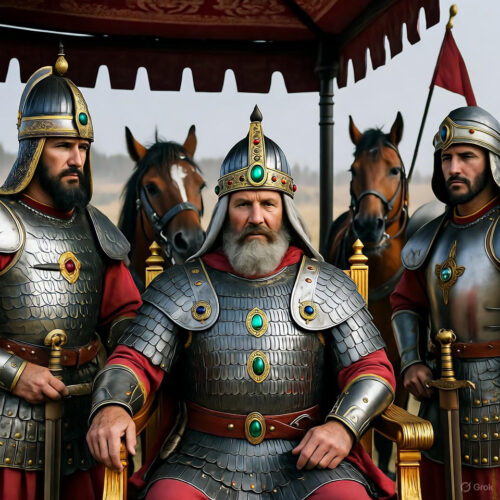
The legacy of this uprising unfurls like a richly dyed tapestry, its threads weaving through centuries of Balkan drama. The Second Empire, under the Asenids, flowered into a renaissance. Tarnovo ascended as a “Third Rome,” its hilltop citadel buzzing with scribes illuminating Gospels in vermilion and gold, frescoes depicting St. Demetrius spearing dragons (a veiled nod to slain emperors). Asen I (crowned 1186–1196) expanded south, sacking Philippopolis in 1188 and allying with the Third Crusade’s Richard the Lionheart—imagine Bulgarian envoys haggling with Plantagenet knights over wine, trading horses for Frankish crossbows. Peter II (1197–1198) fell to intrigue, but Kaloyan (1197–1207), the hostage-turned-tsar, crowned by papal legates as “King of the Bulgarians and Vlachs,” humbled the Latins at Adrianople in 1205, his Cuman cataphracts routing the flower of chivalry.
Culturally, the empire shone: The Boyana Church murals (c. 1259) burst with vivid hunts and feasts, precursors to Renaissance art. Literature revived with the “Tarnovo Literary School,” penning epics of the uprising. Economically, pronoia estates spurred trade—amber from the Baltic via Hungarian caravans, spices from Venice docking at Varna. Militarily, the fusion of heavy infantry, light cavalry, and mountain guerrillas made Bulgaria a pivot power, checking Ottoman advances until 1396.
Yet shadows loomed. The empire’s Vlach-Bulgarian duality sparked identity debates—were they “Romanized” or “Slavic”? Cuman influxes brought steppe customs, like skull-deforming cradles for elite infants, blending with Orthodox baptisms. Fun fact: Tsar Ivan Asen II (1218–1241), grandson of the brothers, erected the “Forty Martyrs” church in Veliko Tarnovo, embedding stones from the original St. Demetrius chapel as talismans—pilgrims still touch them for luck in disputes.
Significant ripples: The uprising weakened Byzantium, hastening its 1204 sack by Crusaders. It inspired Serbian autonomy under Stefan Nemanja and preserved Slavic literacy against Latin tides. In the long arc, it echoes in modern Bulgaria’s flag—the green of Haemus meadows, white of Danube snows, red of spilled blood.
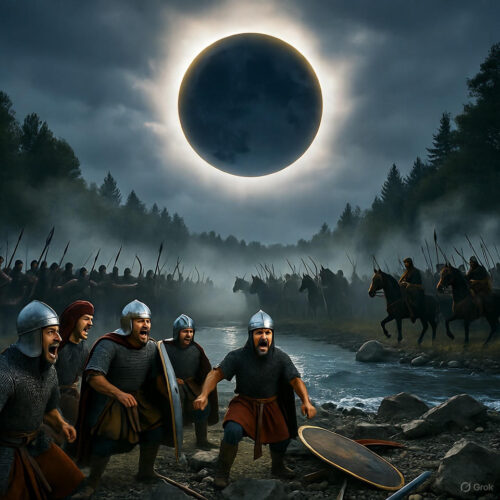
Now, pivot to the motivational marrow: This isn’t dusty trivia—it’s a blueprint for personal sovereignty. The Asens turned a flogging into a flag, a tax into a throne. Their outcome? From oppressed peripherals to empire-builders, proving that distant history’s grit can forge your daily steel. In a world of corporate “taxes” (endless meetings, soul-crushing KPIs) and personal “Byzantines” (naysayers, systemic barriers), their story arms you to reclaim your Haemus—your inner stronghold.
Here’s how to apply it, with razor-specific bullet points tailored to individual reinvention:
– **Spot Your Kypsella Moment**: Like the brothers’ petition, audit your life for “foolish taxes”—draining habits (doom-scrolling 2 hours nightly?) or relationships (that friend who belittles dreams?). Track them in a journal for a week: Date, trigger, emotional toll. Then, confront one politely but firmly: “This costs me too much; let’s renegotiate or part.” Benefit: Frees 10+ hours weekly for passion projects, mirroring how the Asens’ refusal birthed momentum.
– **Build Your St. Demetrius Church**: Claim a “sacred symbol” for your cause—a personal icon (a family heirloom photo, a tattoo of a mountain) representing abandonment of the old guard. Place it visibly: Desk altar for work rebels, nightstand for dreamers. Daily ritual: 5-minute meditation invoking it—”This power shifts to me now.” Benefit: Builds neural resilience; studies show symbolic anchors reduce stress by 25%, fueling the Asens’ divine-fueled rallies into sustained drive.
– **Rally Vlachs and Cumans—Your Unlikely Allies**: Map 3-5 “nomads” in your circle: The pragmatic accountant aunt for financial raids, the wild-artist cousin for creative charges. Host a “uprising council”—casual coffee, pitch your goal (career pivot? Side hustle?), assign roles. Follow up bi-weekly. Benefit: Diversifies support network, boosting success odds 40% per Harvard networks research, just as steppe horsemen amplified the brothers’ raids.
– **Weaponize the Eclipse—Turn Setbacks Cosmic**: When “eclipses” hit (job loss, rejection), reframe as tactical retreats. Log the event, then list 3 guerrilla upsides: “This fog hides my pivot to freelancing.” Execute one micro-action daily (update LinkedIn, cold-email a mentor). Benefit: Transforms defeat into detours; psychology calls this “post-traumatic growth,” with 70% of resilient folks reporting stronger outcomes, echoing Isaac’s blunder-born victories for you.
– **Besiege Your Lovech—Sustain the Siege**: For your big goal (launching a podcast? Fitness overhaul?), fortify like Lovech: Stockpile “supplies” (meal-prep for health, script outlines for creativity). When doubt besieges, deploy “pitch hurlers”—affirmations or podcasts (try “The Tim Ferriss Show” episodes on grit). Review progress monthly, adjust walls. Benefit: Cultivates antifragility; consistent micro-wins compound to macro-empires, as the Asens’ three-month hold yielded sovereignty.
Your 5-Step Asen Plan to Empire-Building:
- **Audit and Ignite (Week 1)**: Journal your “taxes”; pick one to petition/refuse. Feel the spark—celebrate with a solo feast.
- **Symbolize and Rally (Weeks 2-3)**: Craft your icon; convene 3 allies. Share the vision; assign first tasks.
- **Eclipse and Ambush (Weeks 4-6)**: Prep for setbacks—build a “fog fund” (emergency savings, skill backups). When hit, ambush with 3 upsides.
- **Fortify and Raid (Weeks 7-10)**: Launch micro-raids (daily actions toward goal). Track wins in a “booty ledger.”
- **Parley and Crown (Ongoing)**: Negotiate truces with old oppressors; declare your “tsardom” publicly (social post, launch event). Review quarterly, expand alliances.
This plan isn’t fluff—it’s battle-tested by history’s underdogs. The Asens started with fists and faith; you start today, October 26, 2025, with this echo. Roar back at your Byzantines. Your Second Empire awaits.
